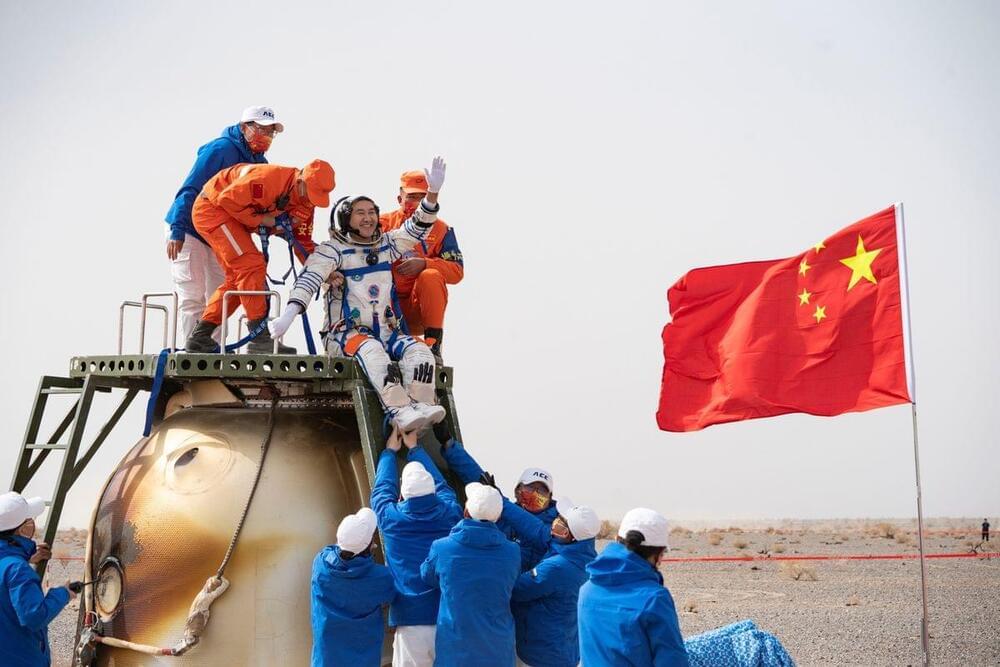The moon lost its magnetic field billions of years ago. What are these strange pockets of magnetism on its surface?



San Mateo, California — A California startup is doing its part to cut down on greenhouse gas emissions by creating a new kind of “meat” that’s made from air.
CBS News was given an exclusive sneak peak at a product that physicist Lisa Dyson says has the taste and texture of meat, but does not come from animals. It’s created using a fermentation process, similar to making yogurt. But instead of using microbes that consume milk and sugar, it’s made from microbes that eat oxygen, nitrogen and carbon dioxide.
How does it work?
Adam FordAdmin.
I’m sure that’s not Deepmind’s official position atm — Nando de Freitas’s tweet was probably reactionary.
Nikolai Torp DragnesDoesn’t really read like the AGI is in a happy comfortable place does it? “Big red button,” “agents,” etc.? Sounds more like being locked in a cage with a gun to your head told to behave, told what to think, what to feel, what to do and what to look a… See more.
2 Replies.
View 11 more comments.
Shubham Ghosh Roy shared a link.

Space today is a three-horse race with the US, China, and SpaceX in the lead. Russia’s Roscosmos is falling back while ESA, Japan’s JAXA, and India’s ISRO are trying to make a run.
“There’s going to be a new world order out there, and we’ve got to lead it,” US President Joe Biden said after Russia’s war in Ukraine upended global geopolitics. Far from Earth, that transition is already happening.
Just like in the era of Sputnik and Apollo more than half a century ago, world leaders are again racing to achieve dominance in outer space. But there’s one big difference: Whereas the US and the Soviet Union hashed out a common set of rules at the United Nations, this time around the world’s top superpowers can’t even agree on basic principles to govern the next generation of space activity.
The concept of Transhumanism has been around for a long time, but it actually looks like it’s starting to happen. In today’s video, we will look at how humans are already merging with machines and what will come next. IPhone wireless charging cases — https://amzn.to/3bz0oRg.
IPhone Backup — https://amzn.to/3w8Usbj.
Wireless Earbuds — https://amzn.to/2ZTjwau.
IPhone Bargains — https://amzn.to/3jXvCGb**** Gears and Equipment we use****
1. Fully Automatic Espresso Machine — https://amzn.to/3bdHcbr.
2. Perfect Desk Chair — https://amzn.to/2ZlMNd2
3. Wireless Mechanical Keyboard — https://amzn.to/3pA71Lw.
4. Wireless DTS Headphone — https://amzn.to/3juz2Qv.
5. Vocal Microphone — https://amzn.to/2XEDsN4
6. UltraWide Monitor — https://amzn.to/3jyteWg**** Free Handy Tools YOU must try ****Tubebuddy – https://bit.ly/3y0SOc6
In-depth channel/video analysis, SEO statistics, Channel optimizationHere at Future Now we aim to bring you the most informative, fascinating and engaging Technology videos on YouTube.🔔 Subscribe To Our Channel: https://bit.ly/3nRoVH8
Copyright Disclaimer:
Under section 107 of the Copyright Act 1976, allowance is made for “fair use” for purposes such as criticism, comment, news reporting, teaching, scholarship, education and research. Fair use is a use permitted by copyright statute that might otherwise be infringing. Non-profit, educational or personal use tips the balance in favor of fair use. *DISCLOSURE*
We are affiliated, but not sponsored by any product featured in this video.
Some links in the description are affiliate links to products, which means if you click on them and buy the product, we will receive a small commission.
Not being sponsored allows us to keep our own opinions and provide product reviews without bias. From the millions of products, we appreciate your support.#Exoskeleton #Cyborg #Transhumanism

Over the last few decades, the high consumption of energy from fossil fuels has promoted a massive increase in greenhouse gas emissions worldwide. To address this, scientists have been searching for an alternative, renewable sources of energy.
One of the main candidates is hydrogen produced from organic waste, or biomass, of plants and animals. Biomass also absorbs, removes, and stores CO2 from the atmosphere, while biomass decomposition can also bring us ways to negative emissions or greenhouse gases removal.
Now, EPFL researchers have developed a way to maximize hydrogen yields from biowaste within a few milliseconds. The method uses rapid photo-pyrolysis to convert dried biomass powders such as banana peel into valuable gases and solids, including hydrogen and biochar.
Earthquakes do more than buckle streets and topple buildings. Seismic waves generated by earthquakes pass through the Earth, acting like a giant MRI machine and providing clues to what lies inside the planet.
Seismologists have developed methods to take wave signals from the networks of seismometers at the Earth’s surface and reverse engineer features and characteristics of the medium they pass through, a process known as seismic tomography.
For decades, seismic tomography was based on ray theory, and seismic waves were treated like light rays. This served as a pretty good approximation and led to major discoveries about the Earth’s interior. But to improve the resolution of current seismic tomographic models, seismologists need to take into account the full complexity of wave propagation using numerical simulations, known as full-waveform inversion, says Ebru Bozdag, assistant professor in the Geophysics Department at the Colorado School of Mines.

March 13 (Reuters) — Ukraine’s defense ministry on Saturday began using Clearview AI’s facial recognition technology, the company’s chief executive told Reuters, after the U.S. startup offered to uncover Russian assailants, combat misinformation and identify the dead.
Ukraine is receiving free access to Clearview AI’s powerful search engine for faces, letting authorities potentially vet people of interest at checkpoints, among other uses, added Lee Wolosky, an adviser to Clearview and former diplomat under U.S. presidents Barack Obama and Joe Biden.
The plans started forming after Russia invaded Ukraine and Clearview Chief Executive Hoan Ton-That sent a letter to Kyiv offering assistance, according to a copy seen by Reuters.


Circa 2014
As a seventh grader, I was lucky to land the job of ball boy for the Brooklyn Dodgers during their annual late-March exhibition games in Miami. The experience left me with fond memories — of Roy Campanella smoking a cigar as he stroked line drives in the batting cage, of a young Sandy Koufax throwing harder than seemed humanly possible and of an aging Jackie Robinson struggling to remain in the lineup.
Oddly, however, my most vivid memory is of the Dodgers’ longtime batboy as he sat in the locker room producing autographed baseballs. He’d twist his hand at odd angles as he scrawled replicas of the signatures of Duke Snider, Pee Wee Reese and other Dodger legends. To my untrained eye, the balls he inscribed were indistinguishable from those signed by the players themselves.
Handwriting experts probably could have identified his forgeries without difficulty, but technology has progressed considerably since then. In many domains, perhaps even including signed baseballs, it’s becoming possible to produce essentially perfect replicas of once rare and expensive things.